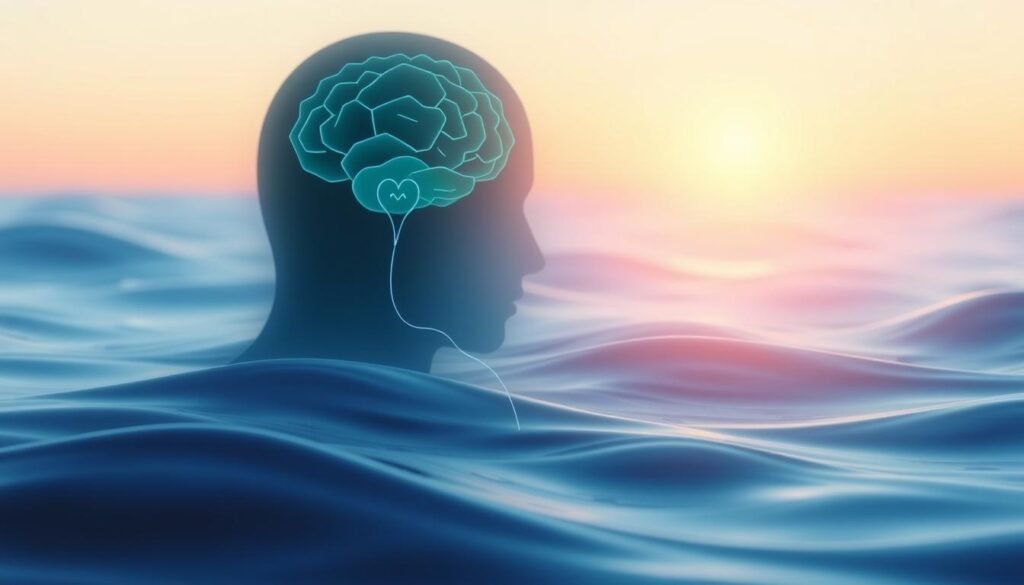Did you know about 31.1% of adults in the U.S. will face an anxiety disorder at some time? This high number shows why knowing how to get diagnosed is key for many. Anxiety shows up in different ways and can greatly affect everyday life.
This calls for a careful look at the symptoms. To name the disorder, you go through several steps. These include different tests and talking to professionals.
We want to shed light on how complex diagnosing anxiety can be. Also, we’ll cover how to spot and deal with it effectively. By recognizing the early signs and asking for help, you can move towards better mental wellness.
Spotting signs like a fast heartbeat or tense muscles is crucial. It helps tell if you might have an anxiety disorder. Learning about these physical clues is a big step. With the right information and support, finding the path to treatment and ways to cope becomes clearer.
Key Takeaways
- Anxiety disorders affect around 31.1% of adults in the U.S.
- Identifying symptoms is crucial for effective anxiety diagnosis.
- Professional consultations are a vital part of the diagnosis process.
- Physical symptoms can significantly impact one’s daily life.
- Understanding anxiety can lead to better coping strategies and treatments.
Understanding Anxiety Disorders
Anxiety disorders are mental health issues that cause a lot of fear or worry. It’s important to know about these symptoms. This helps us tell the difference between normal worries and more severe problems. Around 20% of American adults suffer from anxiety disorders yearly. Their symptoms often disrupt daily life for six months or longer. Knowing the difference between standard anxiety and an anxiety disorder is key for seeking help.
Overview of Anxiety Disorders
There are many types of anxiety disorders, each with its own set of challenges. Generalized anxiety disorder (GAD) is one type. It affects nearly 7 million adults with constant worries about different parts of life. Social anxiety disorder impacts about 15 million adults. It causes great fear of social settings. Panic disorder is seen in about 6 million adults. It involves severe panic attacks. Specific phobias deal with extreme fears of certain things and affect 8% to 12% of adults.
Common Types of Anxiety Disorders
Knowing the various anxiety disorders helps in diagnosing them correctly. The table below shows some common ones:
| Anxiety Disorder | Prevalence in U.S. Adults | Main Characteristics |
|---|---|---|
| Generalized Anxiety Disorder (GAD) | 2.9% | Excessive worry about various events, fatigue, muscle tension |
| Social Anxiety Disorder | Approximately 7% | Avoidance of social situations due to fear of scrutiny |
| Panic Disorder | 2% – 3% | Severe panic attacks occurring repeatedly with a sense of impending doom |
| Specific Phobia | 8% – 12% | Intense fear causing significant impairment; must last six months or longer |
| Agoraphobia | 1% – 1.7% | Fear of situations where escape is difficult, leading to avoidance behaviors |
It’s crucial to recognize these disorders’ signs and get professional help. Symptoms can become too much to handle, but there are good treatment options. Understanding and acknowledging the complexities of anxiety disorders show the need for professional guidance.
For more on how anxiety differs from anxious feelings, check out this detailed article.
Identifying Anxiety Symptoms
It’s crucial to recognize signs of anxiety for understanding its impact on mental health. Symptoms often look like normal stress, making it hard to tell them apart. Knowing these symptoms helps in taking steps to get the right help.
Recognizing Common Symptoms
Those with anxiety might experience several symptoms, including:
- Restlessness or feeling on edge
- Fatigue or exhaustion
- Difficulty concentrating or mind going blank
- Physical signs such as increased heart rate or sweating
- Sleep disturbances, including insomnia or excessive sleepiness
About 31.1% of adults in the U.S. go through an anxiety disorder at some time. This shows how common these symptoms are in different people.
Distinguishing Between Anxiety and Normal Stress
It’s important to know the difference between stress and anxiety. Stress is usually tied to specific events and goes away over time. Anxiety can last longer and get worse without any obvious reason. This can interfere significantly with daily life, affecting around 36% of people. Recognizing these signs is the first step to managing mental health better.

How to Get Diagnosed with Anxiety
The journey to an anxiety diagnosis starts with a visit to your primary doctor. In this initial meeting, you can talk openly about what you’re going through. It’s also a chance to check your physical health and eliminate any medical issues that might be making your anxiety worse.
Initial Steps for Diagnosis
Getting diagnosed with anxiety involves a few important steps:
- Schedule a thorough check-up with a healthcare provider.
- Talk about your symptoms in detail, how long you’ve had them, and how they affect your life.
- Bring any past medical records to help assess any previous health issues.
- Think about seeing a mental health specialist for deeper insight.
The Importance of Seeking Professional Help
It’s crucial to seek professional help for an anxiety diagnosis. Getting help early can make treatment more effective and improve your life. But, only about 37% of people with anxiety get the help they need. This shows a big need for better access to care. Getting diagnosed with anxiety not only confirms what you’re feeling but also leads to the best treatment.

The Anxiety Diagnosis Process
It’s important to understand the anxiety diagnosis process if you’re feeling symptoms. You start by seeing your doctor. They check your symptoms, your health history, and any new behaviors.
Consulting Your Primary Care Provider
Starting with a visit to a primary care facility makes sense. Doctors there look at your symptoms and rule out other health issues. They decide if you need treatment or should see a mental health expert.
Referrals to Mental Health Specialists
If needed, your doctor will send you to a mental health specialist. This could be a psychiatrist or psychologist. They work together to understand your mental and physical health. They use tools like the Hamilton Anxiety Rating Scale for a clear picture of your anxiety. Going through this process helps you tackle your anxiety well. For more information, check this resource.

Psychological Evaluation for Anxiety
Knowing how to evaluate anxiety is key to correctly finding anxiety disorders. This involves looking closely at a person’s thoughts, feelings, and actions. Experts use different tools to make sure the assessment works well. This helps tell the difference between regular stress and disordered anxiety.
The Role of Psychological Assessments
Assessments provide a structured way to check on anxiety levels. Tools like the Generalized Anxiety Disorder Scale (GAD-7) and the Hamilton Anxiety Rating Scale (HAM-A) help. They turn what we feel into numbers. This gives a clearer view of someone’s mental state.
Doing these tests often helps keep track of how well treatments are working. It’s a key part of making plans that really help.
Standard Criteria Used in Diagnosis
When looking at mental health, the DSM-5 criteria are often used in diagnosing anxiety. This book sets the standards for different types of anxiety disorders. It looks at how long symptoms last, how bad they are, and their effect on daily life.
Using detailed assessments and set criteria leads to accurate diagnoses. This blend is important for pinpointing anxiety disorders.
Want to learn more about how anxiety is diagnosed? Find extra info here.
Medical Tests for Anxiety Diagnosis
Anxiety disorders are not just about mental health; physical health is important too. Medical tests are key in finding out if other health issues are making anxiety worse. They help tell anxiety apart from other problems. This makes sure patients get the right treatment.
Understanding the Need for Physical Health Checks
People with anxiety might not know that some health conditions look like or make anxiety worse. It’s important to check if a health issue is behind the anxiety. For example, thyroid problems can make people feel nervous or panicky. Spotting these issues helps doctors diagnose and treat anxiety correctly.
Common Tests that May Be Recommended
Doctors might suggest some tests for diagnosing anxiety. These include:
- Blood Work: To check overall health and hormonal balances.
- Thyroid Function Tests: To see if the thyroid is affecting mood and anxiety.
- Complete Blood Count (CBC): To find conditions that might cause stress or tiredness.
These tests look at how physical health affects anxiety. A full evaluation is crucial for a complete treatment plan. It’s common for people with anxiety to live with symptoms for years before getting the right help. Verywell Health shares studies on this.
| Test Type | Purpose | Common Findings |
|---|---|---|
| Blood Work | Assess overall health | Fatigue, nutritional deficiencies |
| Thyroid Function | Evaluate thyroid health | Hyperthyroidism or Hypothyroidism |
| Complete Blood Count | Screen for underlying conditions | Infections, anemia |
Testing for anxiety can change how we approach treatment, making care more specific to each person’s health. Getting a detailed exam early can lead to better health and handling of anxiety.
Developing a Treatment Plan for Anxiety
After diagnosing anxiety, it’s crucial to make a treatment plan. This plan combines medications for anxiety disorders and therapy. It meets the unique needs of each person. Working closely with healthcare providers is key. They help create a strategy that fits individual preferences and conditions.
Medications for Anxiety Disorders
Medications are important in treating anxiety. Options include:
- Antidepressants (e.g., SSRIs like Sertraline, Escitalopram)
- Anti-anxiety medications (e.g., Benzodiazepines, Buspirone)
- Beta-blockers (to manage physical symptoms)
Medications for anxiety disorders show 60% to 80% effectiveness. This is true especially when combined with therapy. Patients often see a big drop in symptoms within 12 to 16 weeks of starting treatment.
Cognitive Behavioral Therapy (CBT) and Its Effectiveness
Cognitive Behavioral Therapy (CBT) is highly effective for anxiety disorders. It works by changing negative thoughts and actions. This change can lessen symptoms of anxiety. CBT helps 60% to 80% of people with anxiety disorders.
- Exposure therapy to confront fears gradually.
- Relaxation techniques to manage physiological symptoms.
- Cognitive restructuring to challenge and change negative beliefs.
Using both cognitive behavioral therapy and medications often gives the best results. About 70% to 80% of patients see a great improvement in how they function.
Seeking Help for Anxiety Diagnosis
Finding the right support is crucial for managing anxiety disorders. If you’re struggling, seeking a diagnosis is the first step. A trusted mental health professional can tailor guidance to meet your specific needs.
Finding the Right Mental Health Professional
It’s important to choose a professional who specializes in anxiety. You can get referrals from your doctor, check online, or contact mental health clinics. Look at their credentials, treatment methods, and if they match your preferences. A good relationship is key for open communication and support.
Utilizing Support Networks and Resources
Being part of anxiety support networks helps recovery. Friends, family, and groups provide community and encouragement. The National Alliance on Mental Illness and the Anxiety and Depression Association of America offer resources. They have educational materials, support groups, and help services. Using these resources can lessen loneliness and help you fight anxiety.
Conclusion
The first step in managing anxiety is to recognize the symptoms and seek help early. It’s crucial to get professional advice for coping with anxiety. With the right support, creating a plan that works for you is possible.
Getting a detailed anxiety diagnosis is important. It helps in finding the best treatment, which might include medication and therapy. This personalized approach is a key part of improving.
Anxiety disorders are common but complex mental health challenges. Treatment often combines Cognitive Behavioral Therapy with medication, if needed. Having access to support networks and resources is also helpful. It shows you’re not alone in this fight.
Many people with anxiety don’t get the help they need. It’s vital to admit you’re struggling and start looking for solutions. The right help can change your life. You can beat anxiety and look forward to better days.